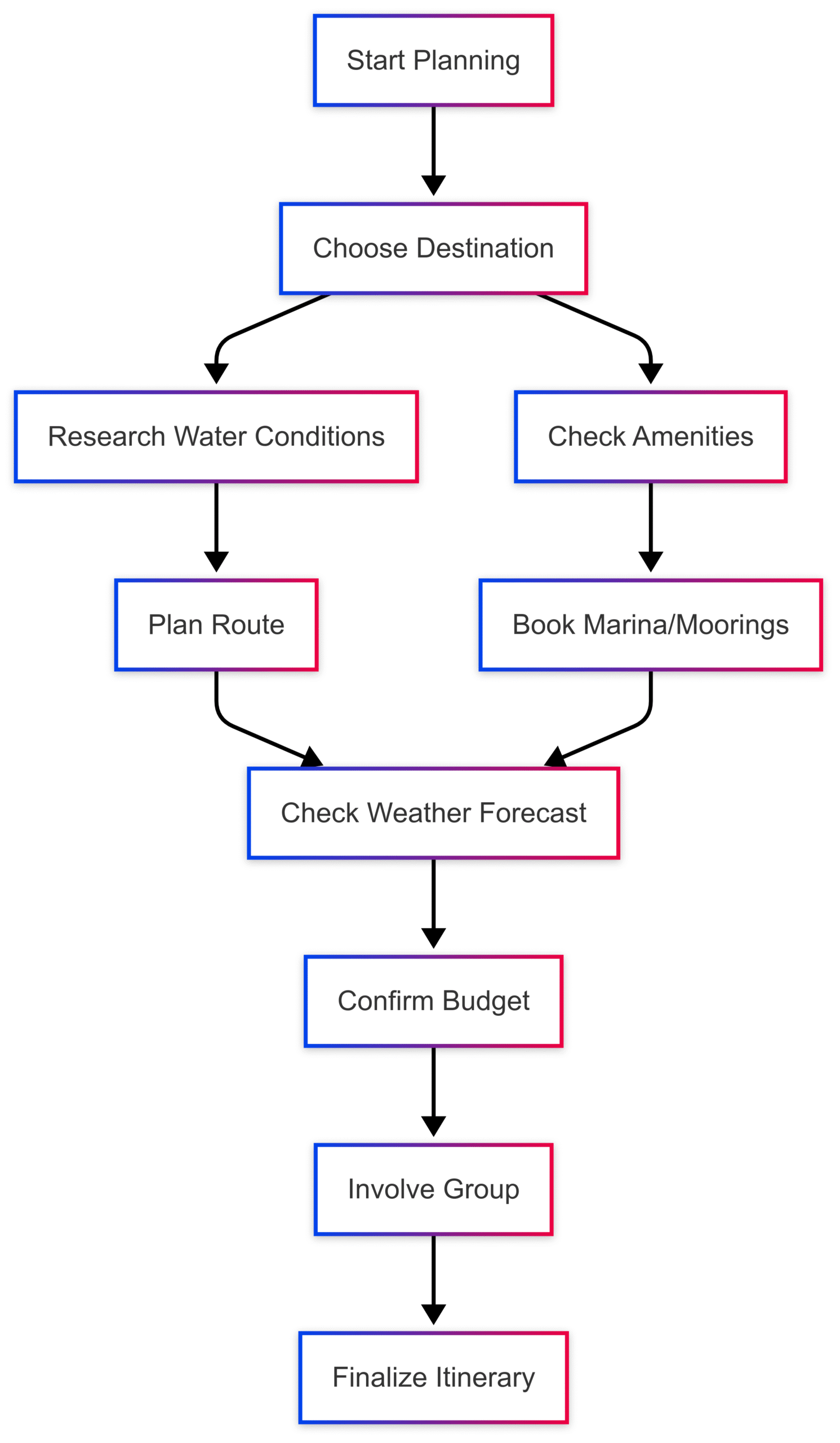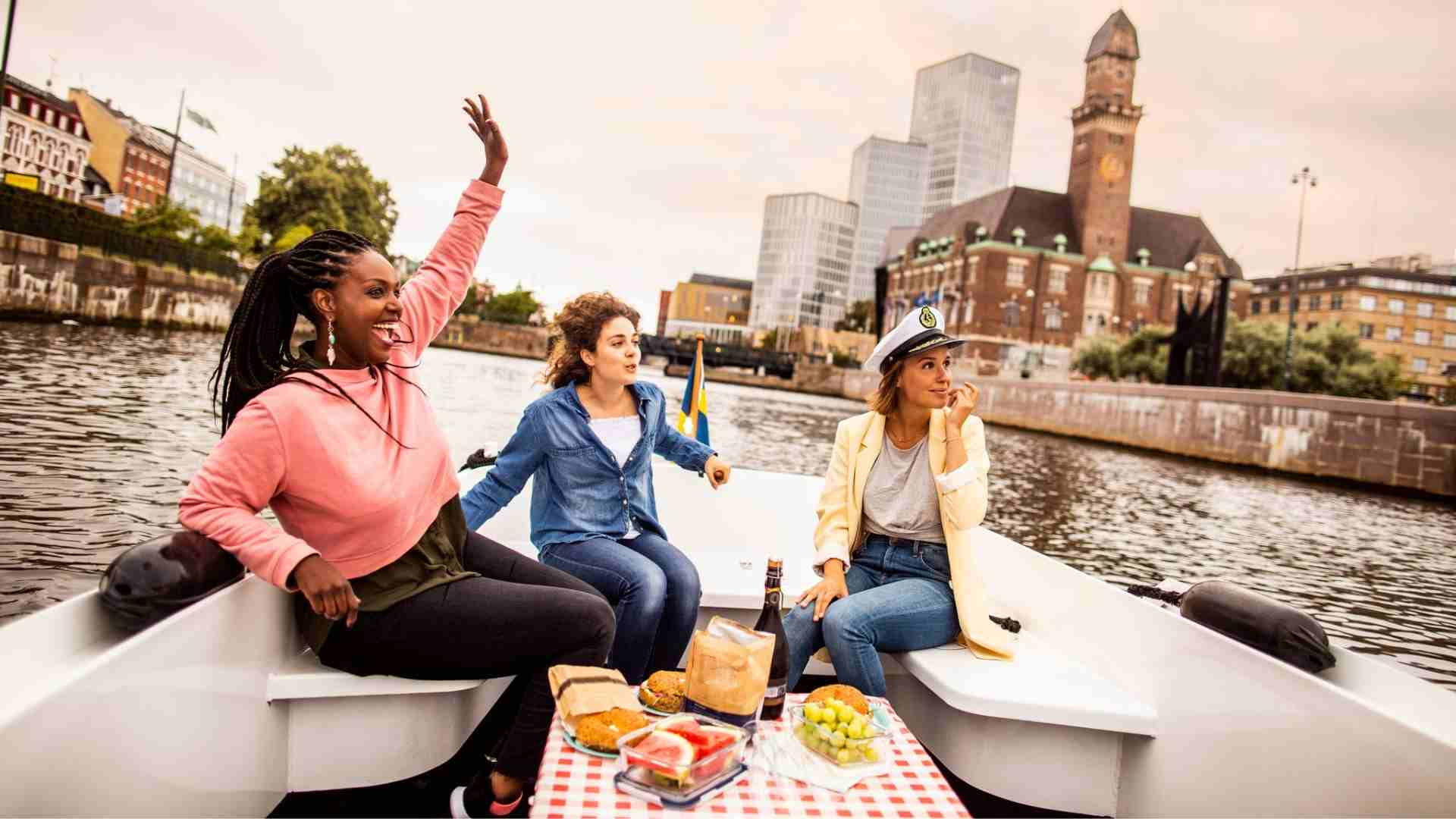How to Plan the Perfect Boat Trip
Plan the perfect boat trip with our comprehensive guide. Discover destination tips, packing essentials, safety checks, and charter options for an unforgettable adventure.
A boat trip offers a unique escape from crowded highways, packed airports, and overbooked hotels. Whether you’re cruising a serene lake, navigating coastal waters, or embarking on an international sailing adventure, meticulous planning ensures a seamless and memorable experience. This guide provides a detailed roadmap for crafting the perfect boat trip, covering destination selection, packing essentials, safety preparations, and charter options. With practical tips, checklists, and expert insights, you’ll be ready to set sail with confidence.
Why Choose a Boat Trip?
Boating vacations combine adventure, relaxation, and the freedom to explore destinations inaccessible by land. Unlike traditional travel, a boat trip allows you to set your own pace, discover hidden coves, and enjoy the tranquility of the water. Whether you’re planning a weekend getaway or a week-long charter, the key to success lies in preparation. This article breaks down the process into actionable steps, ensuring every aspect of your trip is covered.
Step 1: Planning and Research
Choosing the Right Destination
Selecting a destination is the foundation of your boat trip. Your choice should align with your interests, the boat’s capabilities, and the preferences of your group. Consider the following factors:
- Water Conditions: Assess water depth, currents, and potential hazards like narrow channels or low tides. Use nautical charts or digital chart plotters to evaluate your route.
- Proximity and Accessibility: Decide whether you want a short trip to a nearby lake or a longer journey, such as cruising from Florida to Bimini. Ensure the destination is within your boat’s range and your time constraints.
- Amenities and Attractions: Look for destinations with marinas, dining options, or recreational activities like fishing or snorkeling. For example, Chesapeake Bay offers numerous anchorages and coastal towns, while the Greek Isles provide cultural and scenic experiences.
Example Destinations:
| Destination | Type | Highlights | Best For |
|---|---|---|---|
| Chesapeake Bay, USA | Coastal | Scenic anchorages, historic towns | Relaxed cruising, families |
| Florida Keys, USA | Coastal/Island | Vibrant marine life, nightlife | Adventure seekers, divers |
| Greek Isles | International | Cultural sites, clear waters | Romantic getaways, history buffs |
Involving Your Group
A successful boat trip requires buy-in from everyone on board. Discuss the itinerary, activities, and expectations with your group, whether it’s family, friends, or a romantic partner. Consider:
- Skill Levels: Ensure there are enough experienced individuals to assist with tasks like docking or anchoring.
- Special Needs: Account for children, elderly passengers, or those with health concerns. Plan for connectivity if work or emergency services are needed.
- Activities: Align the trip with group interests, such as fishing, swimming, or exploring coastal towns.
Weather Considerations
Weather can make or break a boat trip. Research seasonal patterns and check forecasts closer to your departure. For instance, hurricane season (June to November) affects the Caribbean and Gulf Coast, while late summer in the Northeast can bring cooler temperatures and fewer crowds. Always have a backup plan, such as an alternative destination or indoor activities, in case of inclement weather.
Setting a Budget
Boating trips can range from budget-friendly to luxurious. Key expenses include:
- Fuel: Calculate based on distance and your boat’s fuel consumption.
- Dockage/Moorings: Marina fees vary by location and season. Popular spots may charge $2-$5 per foot per night.
- Provisions: Food, water, and supplies for the trip.
- Activities: Budget for dining ashore, water sports, or entrance fees to attractions.
Sample Budget for a Weekend Trip:
| Expense | Estimated Cost (USD) |
|---|---|
| Fuel (100 miles) | $100-$200 |
| Marina Dockage (2 nights) | $150-$300 |
| Food and Drinks | $100-$150 |
| Activities (e.g., rentals, dining) | $50-$100 |
| Total | $400-$750 |
Booking Accommodations
If staying overnight, secure dockage or moorings in advance, especially during peak seasons like summer or holidays. Contact marinas directly or use online platforms like Boatsetter or Dockwa. For anchoring, research popular spots and arrive early to secure a good location. Always have a backup marina or anchorage in case your primary choice is full.
Chart: Planning Workflow

Step 2: Packing Essentials
Packing for a boat trip requires balancing essentials with limited space. Focus on safety, comfort, and functionality.
Safety and Emergency Gear
- First-Aid Kit: Include bandages, antiseptic, pain relievers, and seasickness medication.
- Tool Kit: Pack screwdrivers, wrenches, and pliers for minor repairs.
- Documentation: Carry boat registration, boating license, fishing permits, and insurance details.
- Towing Service: Ensure your towing membership (e.g., Sea Tow or BoatUS) is active.
- Life Jackets: One per person, properly sized and Coast Guard-approved.
- Fire Extinguishers and Flares: Check expiration dates and accessibility.
Comfort and Recreation
- Sun Protection: Sunscreen (SPF 30+), hats, sunglasses, and UV-protective clothing.
- Swim Gear: Swimsuits, towels, and water shoes.
- Entertainment: Books, board games, fishing gear, or waterproof speakers.
- Comfort Items: Pillows, blankets, portable fans, or sleeping bags for overnight stays.
Provisions
- Food and Water: Pack non-perishable snacks, meals, and extra water (1 gallon per person per day). Include a cooler for perishables.
- Cooking Supplies: If cooking onboard, bring a propane grill or portable stove, utensils, and trash bags.
- Personal Items: Medications, toiletries, bug spray, and dry bags for electronics.
Packing Checklist:
| Category | Items |
|---|---|
| Safety | First-aid kit, tool kit, life jackets, fire extinguishers, flares |
| Documentation | Boat registration, licenses, insurance, towing membership |
| Comfort | Sunscreen, hats, sunglasses, blankets, pillows, fans |
| Recreation | Swimsuits, towels, fishing gear, games, books, speakers |
| Provisions | Food, water, cooler, cooking supplies, trash bags |
Packing Tips
- Pack Light: Use soft duffel bags instead of hard suitcases for easier storage.
- Waterproofing: Store electronics and documents in dry bags or waterproof containers.
- Overprepare: Bring extra food, water, and batteries to account for unexpected delays.
Step 3: Safety and Boat Preparation
Pre-Departure Checklist
Before setting sail, ensure your boat is in top condition:
- Engine and Systems: Test the engine, generator, bilge pumps, and freshwater systems.
- Fuel and Water: Top off fuel and water tanks, and map out refueling stops.
- Electronics: Verify chart plotters, VHF radio, and navigation lights are operational.
- Anchoring Gear: Test the anchor and ensure adequate rode (line) for your destination’s depth.
- Dinghy: Inflate and test the outboard if you’ll use a dinghy to reach shore.
Chart: Pre-Departure Checklist

Navigation and Route Planning
- Chart Your Course: Use a chart plotter or paper charts to plan your route, noting hazards and waypoints.
- Water Depth: Check depths to avoid running aground, especially in tidal areas.
- Tides and Currents: Account for tidal changes and currents that may affect anchoring or docking.
Capacity and Comfort
- Avoid Overcrowding: Adhere to your boat’s capacity limits to ensure safety and comfort.
- Crew Roles: Assign tasks like line handling or navigation to experienced passengers.
Step 4: Chartering a Boat
If you don’t own a boat, chartering is an excellent option. Here’s how to choose the right charter:
Bareboat vs. Crewed Charter
- Bareboat: Offers freedom but requires you to demonstrate boating experience. You’ll handle navigation, anchoring, and systems.
- Crewed: Includes a captain and sometimes crew, providing local knowledge and reducing stress. Ideal for beginners or those seeking a relaxed trip.
Charter Comparison:
| Type | Pros | Cons | Cost (USD, per day) |
|---|---|---|---|
| Bareboat | Freedom, lower cost, hands-on experience | Requires skills, full responsibility | $300-$1,000 |
| Crewed | Stress-free, local expertise, learning opportunity | Higher cost, less control | $500-$2,000+ |
Choosing a Vessel
Select a boat that matches your skill level and group size. Consider:
- Size and Layout: Ensure enough cabins for privacy and space for activities.
- Age and Condition: Newer boats (less than 5 years old) offer modern amenities but cost more.
- Equipment: Check for navigation tools, safety gear, and comfort features like air conditioning.
Booking Tips
- Book Early: Secure your preferred boat and dates, especially during peak seasons.
- Research Companies: Choose reputable charter companies with at least 10 years of experience. Check reviews and ask for references.
- Negotiate: Compare prices and inquire about discounts, especially in the off-season.
Provisioning for Charters
Charter companies often offer provisioning services, saving you time. Alternatively, shop locally upon arrival, but budget for transportation costs. Plan meals to balance onboard cooking with dining ashore to sample local cuisine.
Step 5: Flexibility and Contingency Planning
Weather and Itinerary Adjustments
- Monitor Forecasts: Check weather updates daily and be prepared to alter your route or delay departure.
- Backup Destinations: Identify alternative anchorages or marinas if your primary choice is unavailable or unsafe.
Handling Issues
- Boat Problems: If mechanical issues arise, have a repair plan or contact your towing service.
- Group Dynamics: Be ready to adjust plans if passengers’ needs or preferences change.
Indoor Activities
Pack games, books, or movies for rainy days. Research indoor attractions like museums or restaurants at your destination.
Step 6: Creating a Surprise Boat Trip
For a memorable surprise, tailor the trip to your partner’s or group’s preferences:
- Know Their Interests: Plan activities like snorkeling, cultural tours, or sunset cruises based on their passions.
- Tease the Surprise: Use hints or a scavenger hunt to build excitement without revealing the destination.
- Handle Logistics: Book everything in advance to ensure a stress-free experience for your group.
Practical Tips from Boaters
Online forums like Reddit provide valuable insights from experienced boaters:
- Toilet Situation: Ensure your marine toilet is functional to avoid uncomfortable situations. Consider portable options like 5-gallon bucket toilets for small boats.
- Power Management: Bring a battery jump pack and power banks for electronics.
- Anchoring Safety: Take time to select a secure anchoring spot, especially in unfamiliar waters.
Conclusion
Planning the perfect boat trip requires careful consideration of destinations, packing, safety, and group dynamics. Whether you’re navigating your own vessel or chartering a yacht, preparation is key to a safe and enjoyable adventure. By researching destinations, packing smartly, ensuring boat readiness, and remaining flexible, you’ll create memories that last a lifetime. Set sail with confidence and embrace the freedom of the open water.
Happy Boating!
Share How to Plan the Perfect Boat Trip with your friends and leave a comment below with your thoughts.
Read Packing the Perfect Boat Bag: Essential Tips and Gear for Every Boater until we meet in the next article.







A super helpful guide! It covers everything from safety checks to fun tips—made me feel confident planning my first boat trip. Clear, practical, and easy to follow.